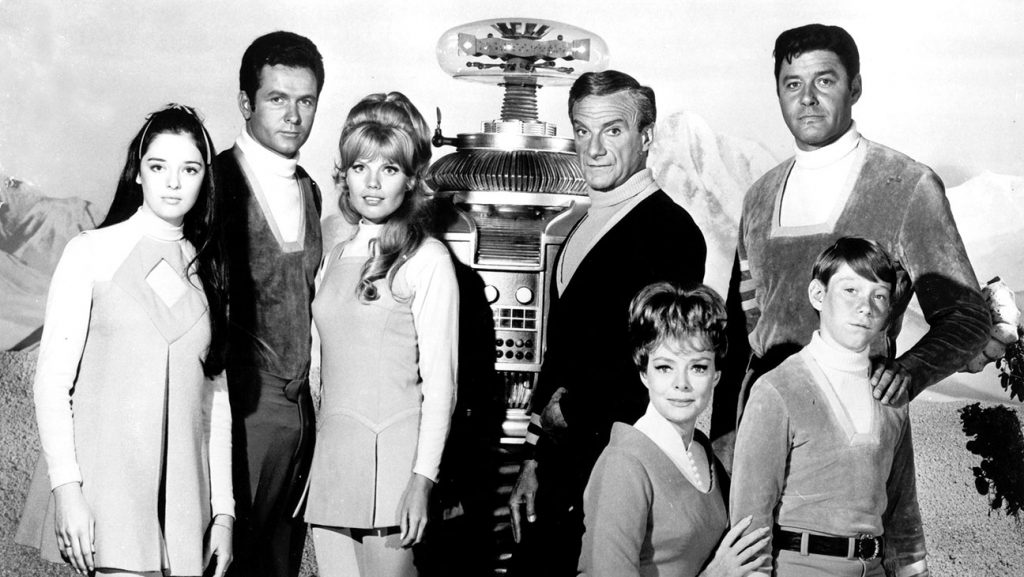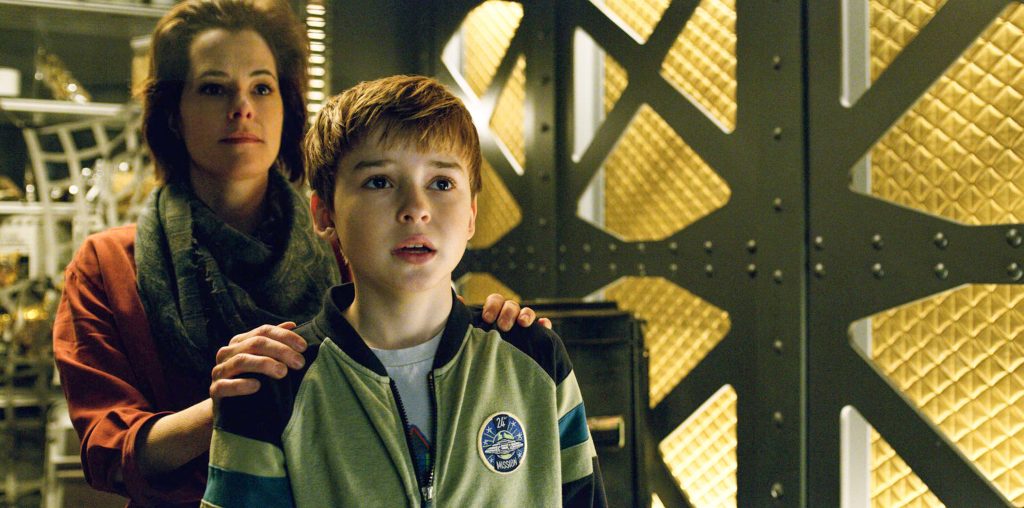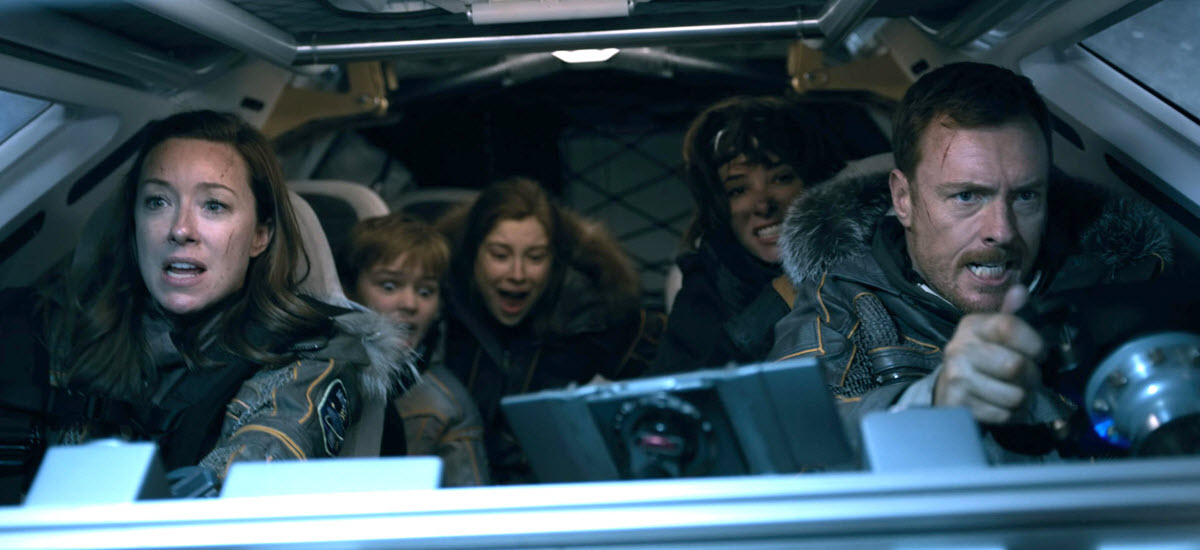There’s a tendency with reboots of classic movies or vintage TV shows to say, “It’s darker than the original.” In the case of Netflix’s upcoming version of Lost in Space, it does look literally darker in the trailers than how we remember the television series, which ran on CBS between 1965-1968. As far as tone, though, it’s hard to judge without seeing an episode. The story seems serious, with some wondrous moments, but not necessarily funny ones. However, there don’t seem to be any hints of an over-the-top Dr. Smith character running outside the spaceship in nightgown and cap calling the robot his “bumbling cracker barrel.”
While moments such as the one described above are proably what people remember about Lost in Space, I wonder how many realize that the series started out much darker. In fact, the first season was broadcast in black and white. It was only the second and third seasons that were broadcast in color and featured not only literally colorful costumes and uniforms, but also figuratively colorful villains and monsters. While the first season focused on adventure, although it didn’t take long for it to start getting silly, the second season purposely became more humorous (supposedly) to compete with another show in the same time slot, ABC’s Batman.

There was also an unaired pilot that contained no mention of the scheming Dr. Smith and the robot, bumbling or not. Known as “No Place to Hide,” the episode actually resembles what I imagine the new Lost in Space could be, at least in tone. On October 16, 1997, which would have been just under 30 years in the future from the date the pilot was filmed, the Robinson family launches from Alpha Control in the Gemini 12 spaceship for Alpha Centauri, “the one planet within our range of technology able to furnish ideal conditions for human existence.” The intention is for them to usher in a new dawn of plenty for all of humanity…
…however, after an unpredicted rain of foil balls… I mean, meteors… throws them off course, “all hope for the Gemini is now gone.” Alpha Control’s final analysis is that the ship must be destroyed, or… “lost in space.” Alpha Control doesn’t know that the Gemini landed safely on a dark, smoky planet. Three and a half years later, on December 3, 2011, we see pages of Professor John Robinson’s diary as he reads them, explaining that it’s been six months since they landed. Their spaceship is disabled, but they hope for repair. They’ve domesticated animals (monkeys and ostriches with headgear) and started a small farm.
After temperatures are forecasted to drop 150 degrees, John and his wife, Maureen, their three children, Judy, Will and Penny, and the Gemini pilot, Major Don West, pack up in their land rover and head for the inland sea, where they hope to find warmth and peace. The journey is treacherous, though, as the crew faces giant cyclops monsters, drives through a lightning storm, and discovers an abandoned castle inside a cave. Then the rover becomes a boat and loses power just as it’s sucked toward a giant whirlpool. The crew ends up safe on shore on December 8, 2001, with John’s “every instinct” telling him there are wild, wonderful adventures just ahead.
Much of this footage is incorporated into the “real” first episode of Lost in Space, called “The Reluctant Stowaway.” The biggest difference, plotwise, is that the spaceship, now named, “Jupiter 2,” doesn’t land on a planet, dark and smoky or otherwise. It ends with a freeze-frame cliffhanger in which John is floating in space when his tether to the ship breaks as he’s trying to make repairs. Captions appear on screen, as they do at the end of every episode of the first two seasons, that read, “To be continued next week! Same time – same channel!” Jupiter eventually lands and the crew experiences similar adventures as it did in the unaired pilot.
The biggest difference in the overall concept of the show between unaired pilot and “The Reluctant Stowaway” is that, while the spaceship going off course is still somewhat accidental, it’s related to what we today might call a terrorist attack. The opening narration now includes the line, “Other countries would go to any lengths of sabotage.” At that moment, Dr. Zachary Smith appears from a cabinet on board and programs the robot to destroy the ship eight hours after launch. This Smith is ruthless, knocking out a solider who threatens to interfere and tossing him into the waste disposal.
He’s delayed by this action, though, and finds himself trapped on board during takeoff. His additional weight has caused a change in course, which sends them into the meteor/foil ball storm. Then the robot starts destroying and before anyone can stop it, the ship slips into hyperdrive, stopping at a place where there’s not one constellation they can recognize. In this version of a first episode, the situation is deemed more serious at Alpha Control. Instead of fearing that the ship is simply “lost in space,” it’s “presumed to be hopelessly lost in space.” That’s a pretty dark thought and a pretty dark introduction to the series.
The Smith dynamic is compelling, providing a consistent villain throughout the run of the series, even though actor Jonathan Harris is always credited as “Special Guest Star.” But he becomes less threatening as he becomes more ridiculous with each episode. He begins as someone who manages to spin being blamed for their condition into being someone who deserves credit for saving their lives, and he’s so unscrupulous that he tells young Will Robinson he has a deadly virus in order to advocate a return to Earth. By this time in the second season, though, he’s hunting for diamonds underground and, in the third season, he’s erecting a statue of himself.

More than the unaired pilot, black and white first season, or color second and third seasons, the Netflix Lost in Space resembles visually the 1998 New Line Cinema movie adaptation. It’s got a similar palette, which is to say, blues, grays and browns. Dark in appearance, the movie actually begins more hopeful than the series. Instead of Earth being described as a planet that’s nearing self-destruction because of overpopulation, it’s introduced as a place where “warring nations have forgotten their differences” and “have banded together to save the planet.” Even in a perfect world, though, there are “terrorist” forces and the “Global Sedition” prepares to strike.
It’s September 30, 2058, 60 years in the future, based on the year the movie was released. Instead of any of the Robinsons, we’re introduced to Major Don West in order to establish his character as a cocky hot-shot. Whereas the TV family members were always thrilled to be with each other and the parents were always kissing, the movie family is dysfuntional. Will is a trouble-maker at school, John is an absentee father who argues with his wife, and Penny is a Goth rebel. The parents lament, “It will do no good to save the families of the world if we can’t save our own.”
The big-screen Robinsons encountered a number of plot points straight out of the run of the entire run of their television counterparts in a four-part adventure that followed a similar “origin story” with three mini-adventures. In the first, the Jupiter nearly burns up by flying too close to the sun, the crew discovers an abandoned spaceship, an “away team” encounters a Blawp (CGI-animated monkey, sans the headgear), and Will wants to change history via time travel. It’s at times a fun attempt to pay homage to the original Lost in Space with cameos and in-jokes. However, the overall execution does not satisfy 2 decades later, if it even did back in 1998.

A line in the Netflix featurette, “The Robinson’s Journey,” actually sounds a lot like the movie, “They have to survive a dangerous situation, but also as a family.” It’s revealed that the story takes place 30 years in the future, or 2048, ten years before the movie, but 47 years after the television series. The future is the future, right; it’s always changing? It’s also mentioned that the family and crew members will deal with “emotional stress and disconnections.” The latest trailer doesn’t provide too much information about how the Robinsons get lost in space, although we see a circular space station explode and a smaller ship nudged by flying debris.
We can assume the incident is at least partially accidental, but we don’t know the level of involvement by a Dr. Smith character. However, we do see Parker Posey say the line, ” If you have any hope of saving your family, you will help me,” and we can connect the dots with IMDb to see that she does indeed play a Dr. Smith. There’s a heavier focus on young Will Robinson (Max Jenkins) in the trailer, to the point that I’m wondering if all this will be seen through his eyes. It looks like he discovers a robot character, but it may be more alien than machine. Either way, it speaks the famous line, “Danger Will Robinson!”
It looks like the spaceship crashes on a snowy, rocky planet, which is familiar from the original unaired TV pilot, and there’s a verbal exchange: “We may not be safe here.” “How long do we have?” “Weeks.” Then, there’s also an underwater sequence that could be out of “No Place to Hide.” And the trailer ends with a scene similar to the end of “The Reluctant Stowaway,” except that it’s not John Robinson (Toby Stephens) floating in space; it’s Will. Something that’s different to both previous version, and very modern, is the diversity of the cast: Judy Robinson (Taylor Russell) is African-American.
A few months ago, when a big deal was made of revealing Mon-El’s costume on Supergirl, I realized that I’m tired of the dark re-imaginings of comic book and television characters, a craze that I’m going to say started in 1989 with Tim Burton’s Batman. While the grim and gritty remakes and reboots aren’t strictly limited to DC Comics, they are the main perpetrators. I mean, Mon-El’s comic book costume was a colorful red and blue with splashes of yellow. For TV, it’s… black. I call for an end to all the darkness! There’s enough of it in the real world. It’s time for some brightness and, dare I say, humor.
This relates to Netflix’s Lost in Space, because I’m not really interested in another dark series right now. If Thor: Rangnarok is any indication, funny can work in this day and age. I’m more interested in a character-driven show where the comedy or drama comes from the Robinsons, Don West (Ignacio Serricchio) and Smith. Having said all that, I think there’s a good chance I’ll like Lost in Space. Why? Well, there’s a clip in the trailer of Judy kneeling in a field. She claps and colorful flowers appear all around her. To me, that symbolizes color (hope) springing from darkness (despair). I’d like some of that in the story, and in the production.
We’ll find out on April 13, when all episodes of Lost in Space premiere on Netflix.


